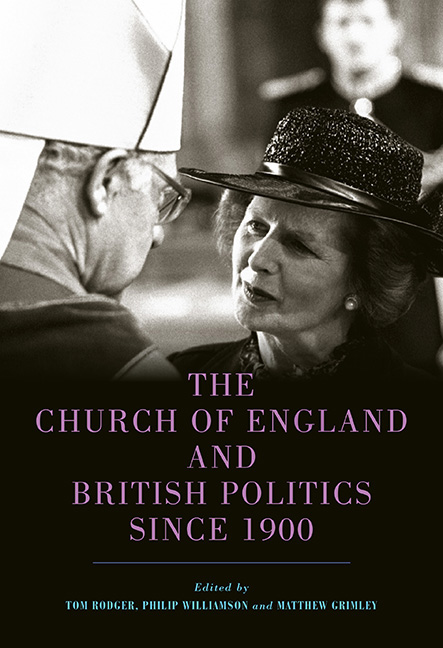Book contents
- Frontmatter
- Contents
- Notes on contributors
- Preface
- Abbreviations and locations of principal collections
- Introduction: the Church of England, the British state and British politics during the twentieth century
- 1 The politics of Church defence: Archbishop Davidson, the national church and the ‘national interest’, c. 1900–14
- 2 Archbishops and the monarchy: leadership in British religion, 1900–2012
- 3 Ecclesiastical conservatism: Hensley Henson and Lord Hugh Cecil on Church, state and nation, c. 1900–40
- 4 Hensley Henson, the prayer book controversy and the conservative case for disestablishment
- 5 Assembling an Anglican view of self-governing sexual citizenship, 1918–45
- 6 Politics in the parish: Joseph Needham at Thaxted, c. 1925–85
- 7 Anglicans, reconstruction and democracy: the Cripps circle, 1939–52
- 8 Parliament and the law of the Church of England, 1943–74
- 9 The Church of England and religious education during the twentieth century 199
- 10 Spiritual authority in a ‘secular age’: the Lords Spiritual, c. 1950–80
- 11 ‘A sort of official duty to reconcile’: Archbishop Fisher, the Church of England and the politics of British decolonization in East and Central Africa
- 12 A ‘baffling task’: Archbishop Fisher and the Suez Crisis
- 13 John Collins, Martin Luther King, Jr, and transnational networks of protest and resistance in the Church of England during the 1960s
- 14 The Church of England, minority religions and the making of communal pluralism
- Index
- STUDIES IN MODERN BRITISH RELIGIOUS HISTORY
8 - Parliament and the law of the Church of England, 1943–74
Published online by Cambridge University Press: 28 April 2020
- Frontmatter
- Contents
- Notes on contributors
- Preface
- Abbreviations and locations of principal collections
- Introduction: the Church of England, the British state and British politics during the twentieth century
- 1 The politics of Church defence: Archbishop Davidson, the national church and the ‘national interest’, c. 1900–14
- 2 Archbishops and the monarchy: leadership in British religion, 1900–2012
- 3 Ecclesiastical conservatism: Hensley Henson and Lord Hugh Cecil on Church, state and nation, c. 1900–40
- 4 Hensley Henson, the prayer book controversy and the conservative case for disestablishment
- 5 Assembling an Anglican view of self-governing sexual citizenship, 1918–45
- 6 Politics in the parish: Joseph Needham at Thaxted, c. 1925–85
- 7 Anglicans, reconstruction and democracy: the Cripps circle, 1939–52
- 8 Parliament and the law of the Church of England, 1943–74
- 9 The Church of England and religious education during the twentieth century 199
- 10 Spiritual authority in a ‘secular age’: the Lords Spiritual, c. 1950–80
- 11 ‘A sort of official duty to reconcile’: Archbishop Fisher, the Church of England and the politics of British decolonization in East and Central Africa
- 12 A ‘baffling task’: Archbishop Fisher and the Suez Crisis
- 13 John Collins, Martin Luther King, Jr, and transnational networks of protest and resistance in the Church of England during the 1960s
- 14 The Church of England, minority religions and the making of communal pluralism
- Index
- STUDIES IN MODERN BRITISH RELIGIOUS HISTORY
Summary
In recent years historians have been interested in the Church of England and the law, but largely in one particular aspect: that of the legislation regarding public morality and its piecemeal liberalization under the governments of Harold Macmillan and Harold Wilson during the late 1950s and the 1960s. While the changes have attracted scrutiny in the round, other scholars have examined individual reforms in their specifically religious aspects (in particular the law on homosexuality and divorce) and the degree to which the Church resisted, co-operated with and instigated change. The significance of this emptying of the ‘moral law’ of its Christian content has been understood largely in its relation to secularization, whether as cause, consequence or both.
However, the focus on legal change through one particular analytic lens has tended to obscure some more subtle but no less profound shifts in the legal status of the established Church. This tendency has been encouraged by the apparently immutable appearance of the relationship of Church and state, as certain matters of great symbolic weight did not change to any substantial degree during this period. Most obvious was the relationship between the Church and the monarchy; there was no serious attempt to reconsider the nature of the coronation service or the status of the monarch as supreme governor of the Church of England. Some efforts were made to adjust elements of the mechanism by which the sovereign’s government of the Church was enacted: the place of the bishops in parliament and the appointment of those bishops in the first place. However, the attempt of the Wilson government to reform the House of Lords – the Parliament (No.2) Bill – failed in 1969, and the position of the bishops in parliament remained unaltered. Crown appointments – of bishops and other church dignitaries – continued to be made by the monarch, acting on advice from the prime minister. The pressure for reform from within the Church had led the archbishop of Canterbury, Michael Ramsey, to appoint a commission, which reported in 1964. However, the report of this commission was overtaken by events and was set aside, and there was to be no material reform in the period under examination.
- Type
- Chapter
- Information
- The Church of England and British Politics since 1900 , pp. 181 - 198Publisher: Boydell & BrewerPrint publication year: 2020

